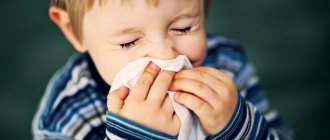Infant dysbiosis
Before being born, the baby is in a completely sterile environment and there are no microorganisms in its gastrointestinal tract. At birth, moving along the birth canal, the baby first encounters the mother’s natural microflora, which normally contains bifidobacteria and lactobacilli, as well as E. coli. In the future, he also “gets acquainted” with the bacteria located in the mother’s mouth and skin. This promotes the colonization of the child’s gastrointestinal tract with normal microflora.
Ideally, a baby who is completely breastfed has 95-99% lacto- and bifidobacteria in the intestinal microflora. And only a small part are the so-called “neutral” bacteria, which have neither positive nor negative effects. These include Escherichia coli, micrococci, enterococci, clostridia, and bacteroides.
If some unfavorable factors are present (lack of natural feeding, late breastfeeding, use of antibiotics), then the balance of microflora may be disturbed, which can lead to adverse consequences for the infant’s fragile body.
The main causes of intestinal dysbiosis in a child
Essentially, there are 2 main criteria that determine the normal microflora.
The quantitative composition , the main and accompanying beneficial microbiota (which includes bifido, lacto, propionic acid and other bacteria), should be 99% of the total number of microorganisms.
High-quality composition . Normally, pathogens of infections and diseases should not be present. Conditionally pathogenic microflora occupies about 1% (these are various Proteus, Pseudomonas, non-pathogenic streptococci, Enterobacter, mold fungi, etc.).
Any deviation from the above factors is called dysbiosis. Experts do not characterize it as an independent disease, but as a consequence of other causes and, as a rule, when choosing treatment, they direct their efforts to eliminate them. So, what can cause dysbiosis, disturbances in the gastrointestinal tract, let us remind you that we are talking about children over 1 year old.
⇒ Unbalanced diet . Today, children eat a lot of sugar, fried and fatty foods, fast food, foods containing artificial preservatives and dyes. Eating at different times, without a specific schedule, also negatively affects the gastrointestinal tract.
⇒ Poor environmental situation . This is especially true for residents of large cities.
⇒ Intestinal infections . They are usually caused by neglect of basic hygiene rules.
⇒ Parasites . It is recommended to carry out preventive measures to remove worms and parasites at least once a year. If there is a specific suspicion, you should consult a specialist.
⇒ Diseases of the digestive system.
⇒ Antibiotics, use of potent drugs . Unfortunately, today people take antibiotics very lightly and use them for any reason. This should not be done, but only as prescribed by a doctor. Dysbacteriosis in children after taking antibiotics is one of the most common causes; it is quite difficult to treat. Metabiotic Daigo can be used in parallel with medications and antibiotics, this will help reduce the side effects of medications and prevent dysbiosis.
⇒ Chronic diseases.
⇒ Allergies of any etiology.
⇒ Dermatological diseases.
⇒ Colds, acute respiratory infections and acute respiratory viral infections ; frequently ill children are at risk.
⇒ Any previous operations.
⇒ Weak immunity.
⇒ Increased psycho-emotional stress, stress.
⇒ Puberty in teenagers, hormonal imbalance.
Causes of dysbiosis in an infant
In infancy, dysbiosis can appear due to the following reasons:
Many experts believe that the child’s body must cope with dysbacteriosis on its own and it is not at all necessary to treat it. maternal health problems that arise during pregnancy;- pathologies during childbirth;
- infections;
- primary immunodeficiency;
- physiological immaturity of the gastrointestinal tract;
- artificial feeding, introduction of dairy products into the baby’s diet at an early age;
- late attachment to the mother's breast;
- antibacterial and hormonal drugs used by mother and baby;
- stress and unfavorable conditions in which the baby lives.
Causes of dysbiosis in children
The main causative factors of a violation of the microflora ratio, with a quantitative and qualitative predominance of pathogenic flora and the development of intestinal dysbiosis:
- The use of antibiotics, especially broad-spectrum antibiotics.
- Severe feeding disorders: placing a newborn on the mother’s breast later than 2 hours after birth, transferring to artificial feeding.
- Acute and chronic gastrointestinal diseases of infectious and non-infectious nature.
- Unsanitized foci of chronic infection and frequent colds and viral diseases.
- Environmental factors: industrial poisons, heavy metals, pesticides, radiation.
Symptoms
Dysbacteriosis manifests itself in children with diarrhea, sleep disturbances and anxiety, tearfulness, a tendency to allergic dermatitis and rashes. These symptoms in themselves are not a reason to make a diagnosis, but should make parents wary.
Characteristic signs of dysbiosis in infants are as follows:
- pale skin;
- flatulence;
- loss of appetite;
- lethargy;
- frequent colic;
- dry skin;
- stomach ache;
- rash, allergy symptoms;
- stomatitis and thrush in the mouth;
- constipation;
- irritability;
- diarrhea lasting more than three days;
- vomiting, nausea, profuse and frequent regurgitation;
- insufficient weight gain;
- presence of blood, foam, green mucus in the stool.
It should be noted that when complementary foods are introduced, there may be a temporary change in the child’s stool, green mucus, diarrhea, allergic rash, and a change in the frequency of bowel movements. Usually these symptoms do not require treatment and go away on their own. Otherwise, you need to look for their reasons. If you notice unpleasant symptoms, show your baby to a specialist.
Dysbacteriosis in infants
13.04.2021
Dysbacteriosis is perhaps one of the most common diseases that a young mother may encounter in the first months of her baby’s life. In this case, the child experiences a modification in the structure and properties of the microflora of the mucous membranes or intestines , which in turn leads to a malfunction of the entire organism as a whole. In our country, by dysbiosis in infants, doctors always mean intestinal dysbiosis , which, according to statistics, occurs in 95% of newborns.
Population of intestinal microflora
We all know very well that a child is born with an almost sterile intestine , in which there are neither “bad” bacteria nor “good” ones, so an important task is to form in the child the correct intestinal , which will be the key to strong immunity , proper development of the body and just good health. baby's mood. Settlement or colonization intestine occurs during labor , when the baby passes through the birth canal. In addition, the baby receives a significant proportion of bacteria from his mother later, during communication and breastfeeding , plus he is exposed to bacteria from the environment.
The role of breast milk
In fact, breast milk is an indispensable source of bifidobacteria, which make up up to 98% of intestinal . These are the same essential probiotics that promote good digestion, the formation of strong immunity , as well as the absence of pathogenic bacteria, which in turn can lead to the development of various diseases.
The precursor to breast milk is colostrum, a unique substance that has simply amazing properties. In addition to bifidobacteria, it contains the immunoglobulins necessary for the baby’s body, which will help his body cope with various infections. That is why today many maternity hospitals pay special attention to ensuring that the baby is put to the breast as quickly as possible.
Causes and signs of dysbiosis
Unfortunately, even a relatively ideal birth and all preventive measures cannot protect your baby from dysbacteriosis one hundred percent. The causes of this disease can go quite deep: these include problems with the intestinal of the mother herself, the consequences of her taking antibiotics and other medications during pregnancy .
Obvious signs of dysbacteriosis in infants are frequent regurgitation, vomiting, bloating , flatulence, colic, poor weight gain, and anemia. Often, green, foamy stool can also indicate a predominance of “bad” bacteria the intestinal But here you need to remember that when the child is completely breastfed, in the first months of the development of bowel , any stool is allowed, the main thing is that the rest of the baby feels good.
Treatment of dysbiosis
It should be remembered that the treatment of dysbiosis is an individual process; there is no one universal remedy. The doctor must take into account all the components of the holistic picture of the disease: establish the causes of dysbiosis , take into account all the symptoms and complaints, and conduct a number of necessary tests . Only after this can you begin treatment.
Published in Gastroentorology Premium Clinic
Degrees of dysbacteriosis
Pediatricians distinguish four degrees of dysbiosis in infants:
- 1st degree. The baby's appetite is disturbed and he is not gaining weight well. Flatulence appears, feces become colorless. The most common cause is poor diet or food allergies. The condition is not dangerous.
- 2nd degree. Characterized by flatulence, abdominal cramps, lack of appetite, constipation or diarrhea. The stool is green, foul-smelling, and contains undigested food. Laboratory testing can detect fungi, Proteus, and staphylococci.
- 3rd degree. Pathogenic microorganisms multiply. The baby may have chronic diarrhea, feces have a rotten smell and a greenish color, and a large number of lumps of undigested food. Immunity deteriorates significantly, symptoms of rickets, rash, flatulence, nausea, and colic are possible. The baby may lose appetite and may feel generally unwell.
- 4th degree. The microflora contains a huge number of pathogenic microorganisms that can cause salmonellosis, dysentery and other infectious pathologies. Harmful microorganisms can enter other organs and provoke inflammatory processes in any organ. A lot of toxins accumulate, which leads to weakness, poisoning, headaches, and fever. Diarrhea can become chronic, and the stool has a putrid odor. The child suddenly loses weight, becomes nervous, and has signs of vitamin deficiency and anemia.
How to understand that a child has dysbiosis?
If your baby is restless and sleeps poorly, he may be suffering from stomach problems.
Nausea, bloating and diarrhea can be caused by dysbiosis. Here is the full list of symptoms:
- Pain and heaviness in the abdomen
- Flatulence, bloating, hard stomach
- Constipation or diarrhea with traces of undigested food
- Belching, nausea
- Poor appetite in a child
- Plaque on teeth and tongue
- Smell from the mouth
- Skin irritation
- Hair loss, brittle nails
When the microflora is disturbed over a not too long period of time, only a few of these symptoms usually appear. However, these symptoms can also signal more serious problems in the child’s body, so you should consult a doctor.
Diagnostics
When diagnosing, the doctor analyzes the symptoms and prescribes some tests:
- coprogram - allows you to determine the degree of digestion of food in the intestines;
- stool culture for opportunistic microflora - reveals the percentage of obligate bacteria;
- stool culture for dysbacteriosis - determines the ratio of healthy and pathogenic microflora and its sensitivity to antibiotics;
Fresh feces of a child (at least 10 grams) must be collected in a special container or a clean glass container. It cannot be stored at room temperature, otherwise the results will not be reliable. It should also be taken into account that if your baby is taking probiotics before collection, they should be discontinued.
Treatment
Parents should not be afraid of the diagnosis, since modern medicine does an excellent job of treating it. Therapy will be faster and easier if the causes of the pathology are determined. If you notice symptoms of dysbiosis in a baby, show it to the doctor as soon as possible - he will diagnose it and prescribe adequate treatment.
Tactics for treating dysbacteriosis
To successfully treat dysbacteriosis in an infant, it is necessary to strictly follow the doctor’s instructions and not engage in “amateur activities.” Treatment is usually quite long. We need special medications that contain live lacto- and bifidobacteria. The treatment regimen is determined by the doctor. Usually, medications that eliminate pathogenic microorganisms are first prescribed, and in parallel with them, sorbents are prescribed to remove toxins from the body.
In the future, tactics are aimed at populating the microflora with beneficial bifidobacteria and lactobacilli using medications and milk formulas. In order to maintain intestinal health, it is recommended that all family members lead a healthy lifestyle.
If the child is still breastfed, then an important point in treatment is the normalization of the mother’s nutrition. You need to consume more fermented milk products and give up fast food, sauces and other harmful foods.
If complementary foods are already being introduced into your baby’s diet, give him fermented milk products every day.
Treatment of dysbiosis with medications
To treat the disease, lactulose preparations are widely used, which are completely safe and well tolerated by children.
Children are often prescribed Linex, which includes bacteria aimed at restoring normal intestinal microflora. The medication is available in capsules. Before use, the capsule must be opened, then its contents must be mixed with a small amount of water. It is also used to prevent dysbiosis during antibiotic treatment.
The main drugs in the treatment of dysbiosis in infants are probiotics and bacteriophages, such as Linex, Enterol, Acipol, bifidumbacterin, bifiform and others. They contain beneficial microorganisms that help restore normal intestinal microflora, as well as vitamins that are necessary to maintain immunity.
Analysis transcript
In healthy babies, the norm is a content of 107-108 CFU/g of E. coli. Analysis of stool for intestinal microflora allows you to obtain information about the presence of certain microorganisms.
Enterobacteriaceae are part of the pathogenic flora; they can cause a lot of diseases, in particular intestinal infections. These include Salmonella and Shigella.
E. coli is part of the normal microflora. Such bacteria create a kind of barrier in the body that protects against the penetration of pathogenic flora.
Lactose-negative enterobacteria belong to pathogenic microflora. Their normal amount is no more than 5%.
To maintain healthy microflora, lacto- and bifidobacteria are needed. When their number decreases, we can talk about dysbacteriosis. The attending physician interprets the test results.
- If you have any symptoms of the disease, you should immediately consult a doctor. You can view a list of gastroenterology clinics on our website
- You will be interested! The article describes symptoms that make it possible to suspect the presence of liver disease in the early stages
- You will also be interested in learning more about the treatment of various diseases of the gastrointestinal tract
What's wrong with this study? Doctors often prescribe it!
- Let's make a reservation: it is prescribed by doctors only in the countries of the former USSR. Outside these states, simple stool culture to detect microflora imbalance is not performed. You will not find any indication of the need for this testing in the WGO guidelines for irritable bowel syndrome, or the ACG (American College of Gastroenterology) guidelines for acute diarrhea, or the AAFP (American Association of Family Physicians) standard for monitoring newborns with colic. Well, of course, there is no diagnosis of “dysbacteriosis” either in the International Classification of Diseases or in at least one (!) non-Russian-language textbook.
- Our gastrointestinal tract is home to at least 1000 (thousands!) species of bacteria, and the number of all identified species is 2172. When performing a “stool test for dysbacteriosis,” we place stool in a nutrient medium and wait for the growth (the appearance of colonies) of approximately 20 species of bacteria, which we have chosen only because they are able to grow in this nutrient medium. Most of the intestinal inhabitants are not cultivated, that is, we cannot see their colonies in a Petri dish with our own eyes. In other words, when drawing conclusions about the state of microflora based on the reproduction of 20 species, we ignore the vast majority of bacteria.
- The normal amount of bacteria in the stool, which we see in the dysbacteriosis test form, was determined in an unknown way. There is an entire industry standard for treating patients with dysbiosis. There is not a single phrase in it about why we should consider the content of any enterococci from 10^5 to 10^8 per gram of stool to be normal. The standard is full of references to literature, but, suspiciously, there is not a single foreign publication among them. Well, the articles and textbooks themselves do not describe how exactly the microflora of healthy and sick people was compared, that is, how exactly the conclusion was made about the normal content of a particular bacterium.
- The bacteria found in stool (which forms in the colon) is not the same bacteria found in the mouth or small intestine. In addition, the bacteria in the stool (that is, in the lumen of the intestine) are not the bacteria that live in the mucus that protects the intestinal wall. In general, an insane amount of foreign bacteria, fungi and viruses “fly” through our digestive tract. Fortunately, most of them cannot get close to the intestinal wall: the parietal microflora that lives there competes with the “aliens.” We call this phenomenon colonization resistance, and it is to it that we owe the fact that the very first opportunistic bacteria swallowed with a glass of Moscow water does not cause diarrhea in us.
- The composition and ratio of intestinal bacteria is different for each person. By studying (not by stool culture, of course, but by the most complex genetic methods) the composition of bacteria in the stool, you can, for example, guess whether a sample belongs to a resident of New York or the Amazon coast. Well, or in which region of a particular country (for example, Denmark). lives the person who sent his feces for analysis. In general, the true composition of the intestinal microflora is our “fingerprints,” and it is ridiculous to assume some kind of general norm, much less judge the “normality” of the flora based on only 20 species out of 1000.
- Whether bacteria will multiply on a nutrient medium depends not only on what bacteria live in the stool, but also on how the stool was collected (from the toilet, from sterile paper), how it was stored (in the refrigerator, near a radiator, near a window ), how quickly they were delivered to the laboratory. How many people who were recommended to test for dysbacteriosis read these instructions, according to which the stool needs to be collected in a sterile container, placed in the refrigerator and carried to the laboratory not by hand, but in a thermos with an ice cube? However, even when performing these actions, a normal doctor cannot interpret the result of the test for dysbacteriosis. Which means he shouldn’t even try to do it.
Colonies of bacteria appeared in the nutrient medium. Fortunately for us, the truly dangerous Salmonella grows in a nutrient medium. Most intestinal bacteria, alas, do not.
Why is dysbacteriosis dangerous?
If left untreated, dysbiosis can provoke various complications that can negatively affect the immune system and the development of the body as a whole. Possible negative consequences of the disease are as follows:
- anemia;
- lack of vitamins and minerals in the body;
- lack of weight gain;
- frequent infectious pathologies;
- gastrointestinal pathologies;
- allergic reactions.
If you are breastfeeding your baby and the child is gaining weight well, then dysbacteriosis is impossible for him.
Prevention of dysbacteriosis in infants
If there is a risk of dysbacteriosis, it is recommended to take preventive measures. For this purpose, doctors often prescribe drugs to restore microflora - this is especially important when using antibiotics.
Also, preventive measures are as follows:
- Early latching of the baby at the breast. This contributes to the formation of strong body defenses and populates the intestines with beneficial bacteria.
- Breast-feeding. But if the child is on an artificial one, then do not despair. You can choose milk formulas that will provide the child’s body with everything it needs.
- Proper and balanced nutrition for the mother.
- Parents' concern for their health when planning pregnancy and during pregnancy.
- Healthy lifestyle of parents in general.
If you follow the specialist’s recommendations regarding treatment and nutrition, you can usually get rid of dysbiosis within a month. If there are concomitant chronic diseases of the gastrointestinal tract, more time may be required.
How to treat dysbiosis in infants
To eliminate dysbiosis and restore microflora, an integrated approach to treatment is required. The therapy concerns all aspects of the baby’s life: his regime, nutrition, and taking medications. At the same time, do not forget about concomitant diseases or complications, for example, such as anemia, vitamin deficiency, and malfunction of the gastrointestinal tract. Regarding nutrition, there are also some recommendations from pediatricians:
- If dysbacteriosis is detected in the baby, the introduction of complementary foods is stopped and continued only after complete recovery.
- You should not introduce new ingredients into the diet of a nursing mother during this period.
- If possible, maintain and prolong breastfeeding.
In addition, it is necessary to adjust the diet and lifestyle of a woman who is breastfeeding:
- Take walks outside and spend as much time as possible with your child.
- Stick to a sleep schedule.
Infants are prescribed treatment after the research results are obtained, and a specific regimen is followed. The first stage of therapy looks like this:
- In accordance with the type of pathogen, bacteriophages are prescribed that destroy bad bacteria.
- To cleanse the body, sorbents are prescribed.
- Enzymes are used to normalize digestion.
The second stage of microflora restoration involves the following actions:
- Probiotics are prescribed, which consist of bifidobacteria and lactobacilli.
- Prebiotics are prescribed; they create an environment for the spread and further development of good bacteria.
- If absorption is impaired, nicotinic or ascorbic acid and B vitamins are additionally prescribed.
- If dehydration is detected, then use Regidron solution.
Probiotics and prebiotics are the main helpers in the fight against dysbiosis.
Medicines
At each stage of treatment, different medications are used. For example, first they prescribe so-called bacteriophages - these are drugs that, thanks to the viruses they contain, eliminate microbes. They remove Pseudomonas aeruginosa, streptococcal, and coliproteus pathogens without affecting beneficial microorganisms.
At the same time, sorbents are used - they rid the body of waste products and toxins; these can be drugs such as Enterosgel or White Coal. They also use enzymes that help restore the digestive system, often Creon 10000.
Then it is necessary to replenish the supply of beneficial bacteria in the intestines, for which medications or milk formula are prescribed. Most often recommended:
— from probiotics: Bifikol (restores the microflora due to the E. coli and bifidumbacteria it contains; the powder for preparing the solution is approved for use by children after 6 months, improves the functioning of the immune system, normalizes metabolism, eliminates harmful microorganisms), Linex, Lactobacterin (these are drugs , which contain immunoglobulins and live bacteria);
— from among the prebiotics choose: Goodluck, Hilak forte. These are products that promote the formation of normal microflora.
To eliminate any unpleasant symptoms accompanying dysbiosis, medications such as:
- Espumisan – eliminates flatulence, removes excess gases;
- Duphalac – fights constipation, restores peristalsis;
- Citroglucosalan – replenishes electrolyte levels after dehydration;
- Enterofuril - an antiseptic for the intestines, fights diarrhea;
- Bepanten – in the form of an ointment, eliminates dryness, redness and flaking of the skin;
- Macropen is an antibiotic agent;
- Diflucan - used in the treatment of fungus.









